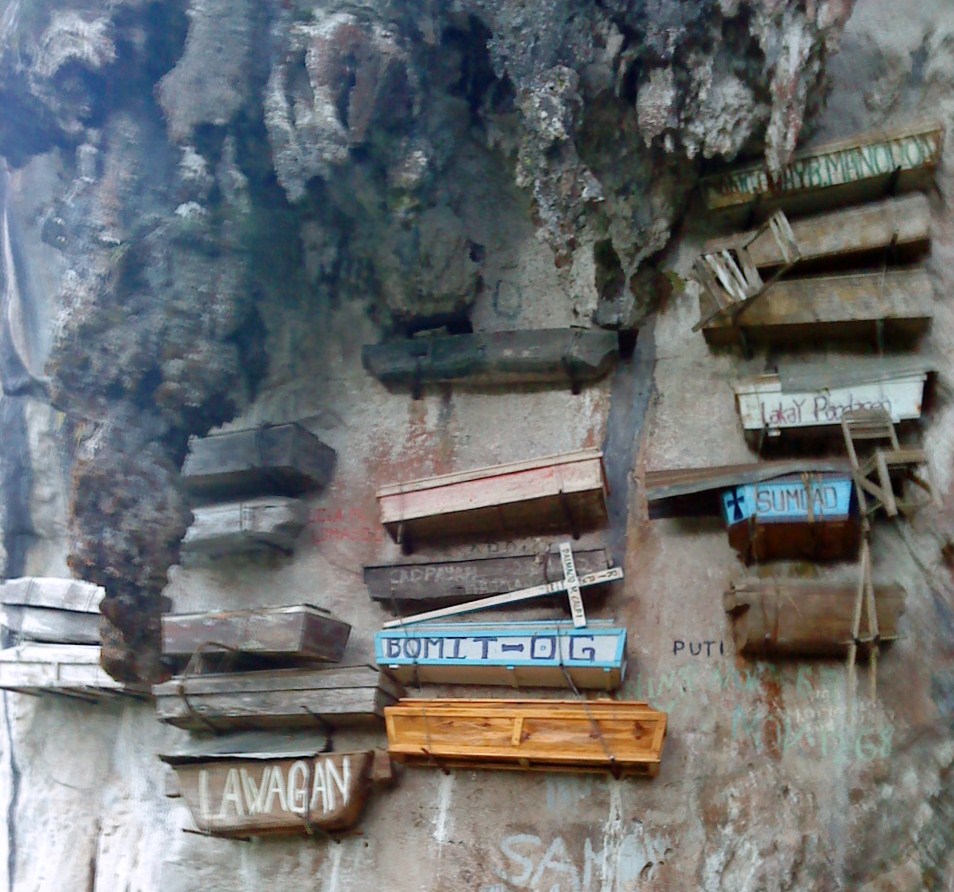
Hanging coffins, kitchen burials, blindfolded corpses, tree trunk burials and coffin hexes, oh my. Tourists flock to the Philippines for the beaches, the food and the cheap medical care but what about the death rituals? Take a peak…
Apayao – This mountainous province in northern Luzon, the largest island in the Philippines, is home to the Isneg people. They live mostly along rivers, in large airy homes adorned with colorful crafts. Homes sit on long wooden posts. Presently, there are about 55,000 Isnegs still living in Luzon. When Apayao people die they are buried under the kitchen area of the house.
Other Great Reads: Funeral customs from around the world
Benguet – Benguet is a landlocked region in Luzon. When an individual there dies they are blindfolded and tied in a chair placed beside the main entrance of their home. The evening before the funeral a special ritual is performed in which elders give a sort of chant-like a biography of the deceased. As the body is buried other members hit bamboo sticks together, which will guide the deceased toward heaven. The largest city in the Benguet region, Bagui City, has recently become a popular tourist destination.
Cavite – This region is located just 10 miles south of the buzzing modern capitol of Manila and yet has retained many traditional customs. Some of the rural people in Cavite still use trees as burial places. The dying person will choose which tree they wish to be buried in beforehand. Then when they become sick or grow very old a hut is built for them close to this tree. When the person dies they are entombed vertically inside the hollowed out tree trunk.
Other Great Reads: Sleeping with Skeletons and Dressing Up Skulls, Halloweens Across the World
Llocos – This region in northern Luzon is filled with colonial churches, the legacy of Spanish Catholicism. Traditional meals include ant eggs, eggplant salad and a vegetable broth called dinengdeng. Here a wife prepares the body of her husband. She takes special care to cloth the corpse, and it is believed that the departed can still convey messages through her during this process. The body is then placed in the coffin in the center of the home, taking great care that it aligns with the planks and floorboards. A wood log is lit in front of the home, as the smoke will assist the spirit to heaven and the fire will repel evil spirits. The log is kept burning during the entire wake. Women wear black clothes and shroud their heads and shoulder areas with a black handkerchief. Before the coffin is taken out of the home, all the windows are closed, and if the coffin hits any part of the home while transporting it out the belief is that someone else will die soon. After the funeral family members wash their hair with a special shampoo, known as gugu, to remove any influences of the spirit.
Llongot – The llongot people live in the Caraballo Mountains on the eastern side of Luzon. Rivers represent their main food source and main source of transportation. The Stanford anthropologist Renato Rosaldo documented headhunting among the llongots during the 1970s and wrote a book on the topic. The Ilongot bury their people in a sitting position. Women are buried with their hands tied to their feet, to prevent their ghosts from roaming . There are presently only about 2,500 llongots left.
Palawan – The people of Palawan are called Palaweños and are known to have buried their dead in burial jars, called Manunggl Jars. These ancient pieces of pottery, found in Manunggul Cave, on the island of Palawan, date back almost 3,000 years. On the lid of the jar is typically found a representation of a human figure, often robed and in a kneeling position. These figures are meant to be souls, riding the boat of the dead and headed across the sea toward their sanctuary in the afterlife. Some of the figures are actually steering with paddles.
Sagada – In the mountainous Sagada region coffins are hung from cliffs. The elderly often carve the coffins themselves. Just like in a typical Western cemetery, the deceased are placed beside their ancestors. The Sagada people have been practicing this ritual for more than 2,000 years. Eventually the coffins will deteriorate and fall. By suspending the coffin from a cliff it is thought to bring the deceased closer to heaven.
Tinguian – The Tinguian people live in northwestern Luzon. For several weeks they will dress the deceased in their best garments and place them sitting on a chair. Sometimes they will even place a lit cigarette between their lips.
Cebuano – The Cebuano people, who form the second largest cultural group in the Philippines, recite the rosary for nine days. They adhere to a number of funerary superstitions, like refraining from sweeping the floor of the deceased’s home and instead collecting the waste by hand. Relatives of the deceased refrain from bathing and combing. No tears are allowed to drop directly onto the casket. Black or white clothing must be worn during the burial, but children are dressed in red, which makes them less likely to see the ghosts of the deceased. Relatives are told to pass under the casket before it is loaded into the vehicle that will be transporting it to the grave. When leaving the cemetery relatives walk through smoke, in order to untangle the spirits of the dead from the bodies of the living.










3 thoughts on “The Spectacular Death Rituals of the Philippines”
Comments are closed.